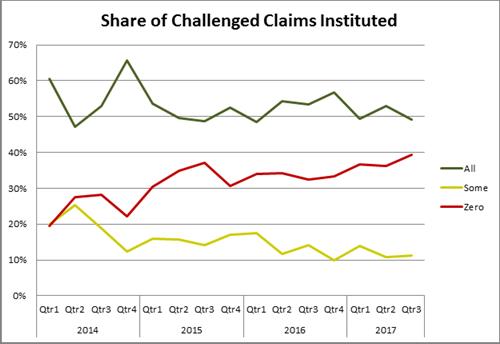On November 27, 2017, the Supreme Court will hear arguments in Oil States Energy Svcs, LLC v. Greene’s Energy Group, LLC, No. 16-712 where the Court will consider the constitutionality of IPR proceedings. The Oil States case has garnered significant attention because of the potential impact it could have on the patent system overall. But also on the docket the same day is SAS Institute Inc. v. Matal. This case covers more routine aspects of IPR proceedings, but it is significant in its own right.
Question presented
Whether 35 U.S.C. § 318(a), which provides that the Patent Trial and Appeal Board in an inter partes review “shall issue a final written decision with respect to the patentability of any patent claim challenged by the petitioner,” requires that Board to issue a final written decision as to every claim challenged by the petitioner, or whether it allows that Board to issue a final written decision with respect to the patentability of only some of the patent claims challenged by the petitioner, as the U.S. Court of Appeals for the Federal Circuit held.
What is the case about?
Under current practice, the Board institutes IPR on a claim-by-claim and ground-by-ground basis, after considering the petition and any preliminary response from the patent owner. As a result, the Board may (and sometimes does) institute an IPR on a subset of the claims challenged in the petition. The conflict with § 318 arises because the Board issues a final written decision only on those claims for which review was instituted—i.e., sometimes on less than the number of claims originally challenged in the petition. According to the petitioner SAS, the Board’s practice cannot be squared with § 318.
What happened below?
In this case, the Board’s split final written decision, following partial institution, invalidated 8 petitioned claims while validating 1 petitioned claim. The decision ignored 7 other petitioned claims that were properly presented for review, but where the ground did not meet the standard for review—i.e., a reasonable likelihood of review.
SAS appealed the sole surviving claim, as well as the Board’s failure to issue a final written decision on all petitioned claims. ComplementSoft, the petitioner, cross-appealed the invalidated claims. The Federal Circuit vacated and remanded as to the surviving claim because Board improperly shifted claim construction in its final written decision. The Federal Circuit affirmed the Board in all other respects. Judge Newman dissented, in part, on Board’s refusal to issue a final written decision addressing all petitioned claims.
Why is it important?
1. The case could have major implications to the estoppel provisions. Under § 315(e)(2), a petitioner is estopped from arguing that a claim is invalid, in District Court, and in the International Trade Commission, “on any ground that the petitioner raised or reasonably could have raised during that inter partes review.” The estoppel applies only where there has been a final written decision, and it is applied on a claim-by-claim basis. So, for claims upon which the Board does not institute review, no estoppel applies, and the petitioner is free to challenge those claims in other venues. If the Supreme Court overrules the Federal Circuit, every claim would have to be addressed in the final written decision and would presumably fall under the estoppel provisions. A Supreme Court reversal may also make it more likely for District Court judges to stay cases pending a final written decision.
2. The case could also have a larger impact on administrative law because the U.S. Patent and Trademark Office (PTO) has invoked Chevron deference in support of its reading of § 318. SAS, on the other hand, says the PTO is not entitled to deference because the AIA clearly states the board must write final decisions on all challenged claims and that the PTO’s policy is not a reasonable interpretation of the statute. Many commentators see the SAS case as a potential vehicle for the conservative wing of the Court to further weaken the administrative state.
What practical impact will the case have on the PTAB?
We provide some in-house institution decision statistics below:
As a practical matter, only 10-12% of institution decisions are partial decisions with some claims instituted and some denied. So if the Supreme Court were to overturn the Federal Circuit’s decision in SAS, the actual impact on the PTAB workload may be relatively small. Nonetheless, if the decision is retroactive, the PTAB will have to implement procedures to deal those IPRs where it instituted review on less than all of the challenged claims. In the end, if the Court reverses the SAS case, much will depend on the relief the court grants to SAS.
This article appeared in the November 2017 issue of PTAB Strategies and Insights. To view our past issues, as well as other firm newsletters, please click here.
Related Services

Receive insights from the most respected practitioners of IP law, straight to your inbox.
Subscribe for Updates
